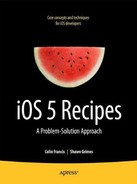Introduction
Once you have already acquired an understanding of the syntax structure of programming in Objective-C for iOS development, the most important part of creating applications is learning to work with the various tools and frameworks provided by Apple. In order to fully develop iPhone and iPad applications, you must have a detailed understanding not only of your development environment, but also of the various elements and functionalities that you are able to use. Regardless of whether your application is playing music, taking pictures, printing documents, or filtering images, this book will help guide you through the setup and building of your functionality.
What to Expect from This Book
The first few chapters of this book are devoted to acquiring a basic understanding of your development environment. You will learn a variety of ways to work within Xcode and Interface Builder, as well as the various standard user interface elements with which you can build your application. The remaining 13 chapters focus on specific examples, or recipes, of a variety of different applications, in order to demonstrate exactly how to implement each functionality from start to finish.
How This Book Is Organized
The example-based chapters of this book do not particularly build off of one another, in the hope that you can simply open up to any chapter of specific interest and start building a certain type of application. However, it is highly recommended that you read the first three chapters in order to acquire a solid understanding of working with Xcode and Interface Builder, if you have not already. Some of the methods used in these early chapters, such as those used to create properties, are referenced throughout the text and should be fully understood.
Throughout this book, it is assumed that you are developing in the latest versions of iOS (5.0) and Xcode (4.2) at the time of writing. This means that every recipe in this text assumes that you will be using ARC (Automatic Reference Counting), and as such does not include significant memory management. This also means that depending on when you are reading this, your results may look slightly different, though the basic functionality should remain similar.
Many of the recipes in this book cannot be fully tested on the iOSsimulator, and as such will require both an Apple device and a provisioning profile, which can be acquired when you subscribe to Apple's iOS Developer Program. Each recipe that cannot be tested in the simulator will mention this fact.
Source Code and Errata
All the source code used in this book is available online for download at www.apress.com, and it is entirely free for use in any application, whether commercial or personal. A number of people have worked hard to keep this code as perfect and error-free as possible, but a few typos or bugs may become apparent with extensive use. Any corrections to the text or code are available in this book's “Errata” section, also at www.apress.com.
Contact Information
If you have any questions or comments regarding the book or its source code, we would be happy to assist. You can contact either author:
Colin Francis:
E-mail:[email protected]Shawn Grimes:
E-Mail:[email protected]
Web:www.shawnsbits.com
